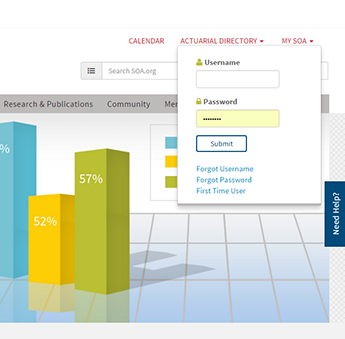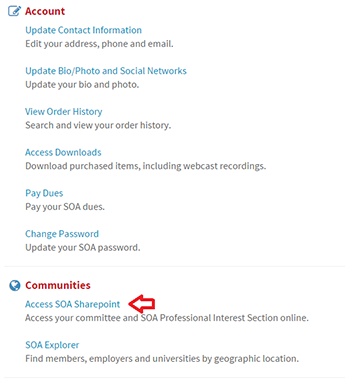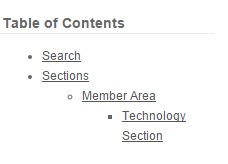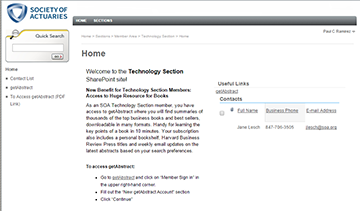 By Mary Pat Campbell
By Mary Pat Campbell
This article first appeared in the August 2013 issue of The Stepping Stone. It is reprinted here with permission.
This is an overview of the getAbstract service, which is provided for free to members of the Technology Section. This a great service that many members are probably not aware of! Below is a step-by-step guide on how to sign up for the service as well as how to use it.
WHAT?
getAbstract is a service that summarizes business-related books in five pages. Each summary consists of a page of bulleted takeaways, a high-level description of the book, and three-and-a-half pages of summary of the content along with some quotes directly from the book in the margins. These summaries come in a variety of formats (PDF, e-book formats, mobile-friendly PDF) and even an audio version (MP3), which is less than 10 minutes for each summary.
WHO?
All members of the Technology Section currently get a free subscription to this service.
HOW?
Go to the SOA website, and look for “My SOA” on the front page:

You will have to log in to your SOA account, if you aren’t already logged in. Once logged in, click on “Access SOA Sharepoint” under the Communities section.

If you have forgotten your login information, contact SOA Customer Service: customerservice@soa.org or +1-888-697-3900.
On the top right of the page, there is a Table of Contents as shown below.

Click “Technology Section” and the Technlogy Section Sharepoint site will come up.

Follow the instructions to getAbstract!
Once you’ve created your getAbstract account, you can have getAbstract email you once a week with a book summary tailored to your interests. Of course, you can also go to the site at any time and find summaries yourself, but it’s nice to have a passive process as an option. Additionally, the weekly email doesn’t require you to login, as the summary is attached to it.
WHY?
Primarily, because you don’t have time to read everything.
One good use of getAbstract is to try to determine whether you want to devote your scarce time to reading a book more fully. Another use is to look up some hot topics, in case you are lacking on the buzz term front. The search function is very easy to use, and there is also a browse feature. The summaries are well organized such that you can decide to browse through finance-related books, and as a sub-topic, risk management. The books summarized cover a wide range of topics, from general leadership concerns to some very technical books.
getAbstract can provide summaries only with the permission of the copyright owner. Some of the most popular business books are missing from getAbstract (for example, Jim Collins’ Good to Great and Sheryl Sandberg’s Lean In) because the copyright holders did not give permission. (Perhaps the publishers’ theory was that if you read the summary, you wouldn’t buy the book. Take that for what it’s worth.) If you try searching for books that getAbstract tried to get permission for but weren’t able to, you will get a message from getAbstract notifying you of the situation, and it will recommend summaries of similar books.
Let me give some tips for getting the most out of getAbstract:
Even though the five-page format has its limitations, you can get a lot of value from this style of presentation.
One of my favorite books, The 48 Laws of Power, is information dense. What does its getAbstract summary look like? Forty-eight numbered items with the title of each item and a one-sentence description. They basically gave a chapter listing as the summary. It’s difficult to do better than that in five pages for a book with so much information.
On the other end is the standard business book, which is basically one point that can be articulated in a sentence, and would have been better treated as a magazine article. (To be fair, many of these started as magazine articles.) Most of the 200 pages of such books are fluff of anecdotes hammering home the one point. The content can barely fill five pages of substantive remarks, so you find that getAbstract summary repeating the anecdotes.
That said, in each of these cases, I am given enough information to determine which is the book of thin content (as the summary will fully satisfy my need for information) and which is information dense and whether I want to look into it further. Given the paucity of information in some books, getAbstract can be a time-saver.
- Ignore the marginal notes.
In fairness, most business books don’t have any punchy lines to pull out. The marginal quotes do little to give you a feel for the book’s writing style. They don’t reflect the content or tone well. For example, none of the summaries for Nassim Nicholas Taleb’s books reflects the constant self-promotion to be found in them.
Just skip them.
- Ignore the ratings except for “Level of Expertise”
Let us not dispute the matter of taste—let us just consider the amount of information conveyed by the ratings. There is not enough variation in the ratings to discriminate between the books. The books have an overall rating out of 10, and the lowest-rated books I could find were rated five. In browsing the current listing of summaries, they have 2,000 books rated eight and higher. Now it may very well be that there are that many excellent business books out there, but this does not exactly help one decide what to look at and what to ignore.
There are three sub-scores that go into the overall rating: applicability, innovation and style. There is more variation in these sub-scores, but it is difficult to use them in trying to determine whether to take the further step to read the book. For example, the “Style” score seems to be a “How easy is it to read?” score, as opposed to a rating of how appropriate the style is to the material. (Can anyone spell Flesch Test?) The “Style” rating for Phillipe Jorion’s Value at Risk was four (Horrors! A score below five! You know that means it’s awful!)—without taking into consideration that it is supposed to be a highly technical book and has an appropriate style to match.
That said, there is one rating that is useful—the “Level of Expertise” rating.
Jorion’s text rates a nine, as it’s indeed not for the uninitiated. While the “Level of Expertise” rating is not in the summaries themselves, you can use it to filter books in the Advanced Search function on the website. While sometimes these can also be somewhat off-the-mark in rating a higher requirement of expertise than it really might require, this can help you hone in on books more appropriate to your level of experience.
WHEN?
Now!
WARNING?
Due to the conversational nature of invoking getAbstract witihin the SOA website, some corporate security protocols may prevent you from using this tool witihn your respective company’s internal firewall. You may need to use the tool at home, cafés, coffee shops, etc.
Mary Pat Campbell, FSA, MAAA, is a vice president, Insurance Research at Conning in Hartford, Conn. She can be reached at marypat.campbell@gmail.com .